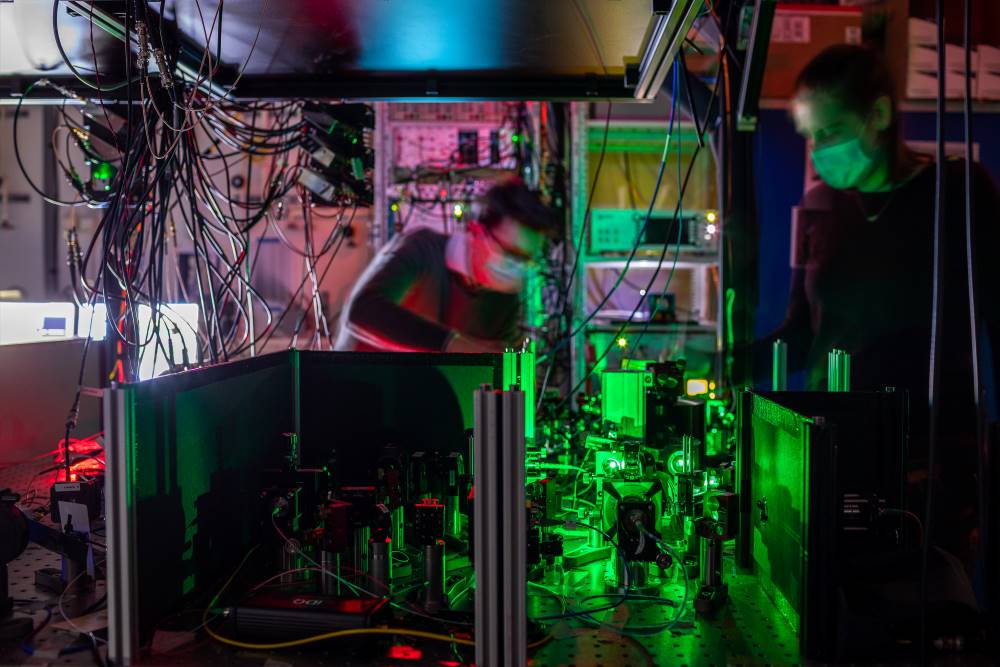Reactions to experimental achievement that would be "a step towards the quantum internet"
A 'quantum internet' would allow, among other things, the flow of inviolable secret messages. Building such a network involves teleporting information between non-interacting elements of the system, something researchers in the Netherlands claim to have achieved. They publish it in Nature.

Carlos Sabín - internet cuántica - EN
Carlos Sabín
Ramón y Cajal Researcher Department of Theoretical Physics UAM Madrid
In a quantum communications network, information could be transmitted using a phenomenon called quantum "teleportation", whereby the state of one quantum bit (cubit) can be transported to another without needing to be known at any time, which is not possible outside of quantum physics.
In order to be able to do teleportation, there must be very strong correlations between the parts (the famous quantum entanglement, which is behind all modern quantum technologies). But quantum entanglement is difficult to achieve and very fragile. Ideally, in a network we would want to transmit information between any pair of nodes, no matter how far apart they are. But how can we achieve entanglement between far apart nodes if each node only interacts with the nodes that are closest to it?
To do this, we have to use the phenomenon of "entanglement exchange", which is the same as teleportation, but now what is being transported is precisely an entangled state of two cubits. Thus, if we intertwine node A with node B and also node B with a third node C, the "intertwining exchange" makes A and C intertwine, even though they have never interacted with each other. And, in principle, we could go on like this with any number of nodes. The experimental problem is that quantum entanglement is very fragile, and it is very difficult to carry out this process without losing information.
Both teleportation and "swapping" have been known theoretically since the 1990s and have been realised experimentally in various quantum systems. But in the specific case of systems that can form a quantum communication network, only teleportation between two neighbouring nodes in the network has been achieved. Until now, an experimental team at the Delft University of Technology in the Netherlands has succeeded in achieving entanglement exchange as well.
This could be interpreted as a first (very preliminary) step towards a quantum communication network. However, it should be noted that the great experimental difficulty means that the quality of information transmission is still very low. This can be measured by calculating the so-called "fidelity" of the transmitted state, i.e. the resemblance between the actual final state of the cubit and the state we wanted to transmit.
Ideally, this fidelity should be 100 %. If it is above 66.6%, we know that the process is impossible without using quantum physics. In the experiment we achieve on average a fidelity of 70 %, but in some states it drops to 65 %. This is enough to show that the process is quantum (at least on average), but obviously still far from any possible technological application, since the state obtained is 30 % different from the original one. Much work remains to be done to improve these percentages and to extend the experiment to more distant nodes in the network.
Miguel Ángel Martín-Delgado sobre internet cuántica - EN
Miguel Ángel Martín-Delgado
Professor of Theoretical Physics
Faculty of Physical Sciences
Complutense University of Madrid
This work is an experimental achievement that seeks to open the door to a large number of possibilities, with the quantum internet as the ultimate goal.
Quantum teleportation has been experimentally tested in multiple occasions and circumstances since it was theoretically formulated in 1993 by a group of six theoretical physicists. It evokes forms of transport from science fiction, but more pragmatically it is the basic operation for quantum communications.
It allows quantum information to be transported between a sender (Alice) and a receiver (Benedict) separated by a certain distance and without violating any of the fundamental laws of physics, such as Einstein's relativity or Heisenberg's indeterminacy principle. But for the transport of quantum information to make more versatile quantum communications possible, we need more nodes (Alice, Benedict, Charles, etc.) and at arbitrarily large distances.
In the experiment reported in Nature by Sophie Hermans, Ronald Hanson and co-workers, a teleportation between Alice's node and Benedict's node is achieved with an extra node of Charles acting as an intermediary. They use spin cubits (quantum information units) embedded in diamonds and connected by fibre optic links. Teleporting states is achieved by guaranteeing their quantum character and with high efficiency. The team has introduced many technical improvements that they hope will be reusable in other quantum platforms, but more information on the range of distances between nodes is lacking.
The use of intermediary nodes in teleportation will make it possible to transport the quantum entanglement over long distances and prevent it from deteriorating along the way. This is the basis for so-called quantum repeaters, the quantum version of the electromagnetic signal repeaters that make radio, television and more modern mobile communications possible.
Quantum teleportation will in the future allow quantum communications to be unified with quantum computing, taking the form of a quantum internet: the nodes will be quantum computers communicating with each other via quantum links using teleportation.
All in all, the current experiment is a necessary advance, but not yet sufficient to cover all the possibilities that will open up when we can further master quantum teleportation in a practical and routine way, and in particular, when we can teleport over sufficiently large distances.
-
Ronald Hanson
Delft University of Technology, Delft, The Netherlands
Email: R.Hanson@tudelft.nl
- Research article
- Peer reviewed
- Experimental study
